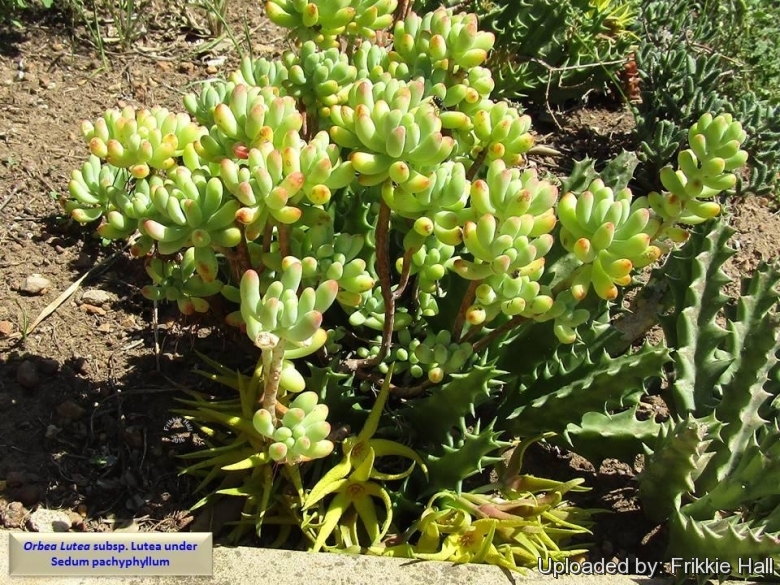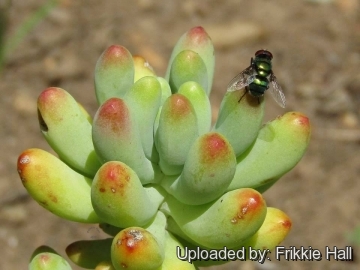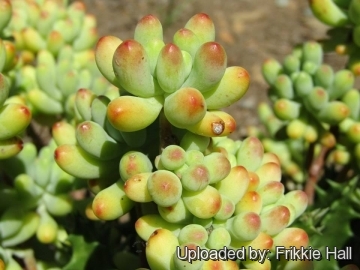




Your support is critical to our success.

Sedum pachyphyllum Crassulaceae Jade Beads Plants (Sedum pachyphyllum) have ovate ball like fleshy leaves that cluster all along the shoots like green beads.
Origin and Habitat: Mexico (San Luis and Oaxaca Sierra Madre del Sur)
Synonyms:
- Sedum pachyphyllum Rose
Sedum pachyphyllum Rose
Contr. U.S. Natl. Herb. 13(9): 299, t. 58 299 1911.
Accepted name in llifle Database:
Sedum pachyphyllum f. cristatum hort.
ENGLISH: Many Fingers, Succulents Water Plant, Blue Jelly Bean, Silver Jelly Beans, Succulent Beans, Stonecrop, Jelly Bean Plant
Description: Sedum pachyphyllumSN|19403]]SN|19403]] is a small perennial bush forming or ground-hugging succulent up to 30 cm tall, with light silvery green, jelly, bean-like leaves along short stems. It spreads over time by rooting stems and fallen leaves that easily take root to form a dense ground cover. It may become very straggly with age. Young plants may be quite compact and will flower, when they are quite small. ln spring large sprays of bigger than usual, widely expanding starry blossoms in buttercup yellow, adorn the plant, with petals long and tapered, as are the carpels, stamens and stigma lobes.
Stems: Woody at base, much branched, upright at first, but later curved and trailing. Up to 5-30(-50) cm long, but usually less and are bare in the lower half. In time of drought the stems carry only a small terminal cluster of leaves.
Leaves: Short, thick, finger-like to club shaped, terete in section, somewhat smaller below, mostly terminal, closely set, standing almost at right angles to the stem upward curved 1 to 4 cm. long, 6 to 10 mm in cross section. They are grey or light green with a glaucous-bluish bloom. Leaf tips usually turn red in winter when kept dry or in sun.
Inflorescence (corymbs): Flowering stem erected or reflexed, axillary, weak, about 2 cm long; inflorescence sessile, cymose.
Flowers: Short-pediceled or subsessile, yellow, with small pure yellow petals. Sepals 5, basally free, widely spreading, spurred, club-shaped, very thick in the upper part, green, obtuse, and very uneven, the longest one 5-6 mm long. Petals 5, yellow, free to the base, sub-ovate, widely spreading, or even bent backward, 5-7 mm long, somewhat keeled on the back, spoon-shaped above, mucronate. Stamens10, long yellow. Carpels at first erect, yellow, carpel beaks are short and stout, style rather broad and short. Nectar-glands small, broader than long and thick.
Blooming season: Flowers appear in the summer.
Fruit: Erect, ovoid.
Seeds: Ovoid, reticulate.
Chromosome number: 2n = 68.
Subspecies, varieties, forms and cultivars of plants belonging to the Sedum pachyphyllum group
 Sedum pachyphyllum Rose: is a bush succulent up to 30 cm tall, with silvery green bean-like leaves along short stems. Distribution: Mexico (San Luis and Oaxaca Sierra Madre del Sur).
Sedum pachyphyllum Rose: is a bush succulent up to 30 cm tall, with silvery green bean-like leaves along short stems. Distribution: Mexico (San Luis and Oaxaca Sierra Madre del Sur).  Sedum pachyphyllum f. cristatum hort.
Sedum pachyphyllum f. cristatum hort.
Notes: Several different forms and cultivars of S. pachyphyllum are common in cultivation, one of the prettiest of them has yellow-green leaves that cluster densely at stem apex with noticeably redder leaf tips. Another form is stouter with more blue-glaucous leaves with only an hint of red on their tips or none at all. Sedeveria humbellii is a very common cross bettween S. pachyphyllum and Echeveria derenbergiiSN|27443]]SN|27443]], but not usually named. Another very common hybrid created in California involves Sedum morganianumSN|12383]]SN|12382]] and S. pachyphyllum and is commonly called Sedum burritoSN|12382]]SN|12383]] or "Giant Burro's Tail".
Bibliography: Major references and further lectures
1) Urs Eggli “Illustrated Handbook of Succulent Plants: Crassulaceae” Springer Science & Business Media, 06 December 2012
2) Stephanie Donaldson “Container gardening: the complete practical guide to container gardening, indoors and outdoors” Barnes & Noble Books, 2008
3) The Bulletin of the African Succulent Plant Society, Volumi 10-12, page 142 African Succulent Plant Society., 1975
4) Joseph Nelson Rose, United States National Museum “Studies of Mexican and Central American plants” 7th edition G.P.O., 1911
5) San Marcos Growers “Sedum pachyphyllum - Stonecrop” retrieved 26 April 2016 from <http://www.smgrowers.com/products/plants/plantdisplay.asp?plant_id=1493>.

Leaves are pale blue-green club-shaped about 2.5 cm long, slightly upturned and flushed red. Photo by: Frikkie Hall

Sedum pachyphyllum Photo by: Frikkie Hall
Cultivation and Propagation: Sedum pachyphyllumSN|19403]]SN|19403]] is an easily grown succulent that can tolerate sun, shade, moist soils, dry soils, but looks its best only when given adequate lightlevels and water, and ideally should be grown outdoors in full sun. It is cultivated as an ornamental plant, it makes a superb container plant in frost-prone areas and can be an attractive part of rock gardens between stepping stones or in wall niches in frost-free localities. With its extreme drought resistance, it needs only minimal care to reward you with its attractive jelly bean texture, bright red summer leaves and spiky yellow flowers, although attractive, it can become a nuisance as the leaves fall off and produce new plants wherever hit the ground.
Exposure: Generally speaking, the more light a plant gets the better it will display its colours and shape. Bright light is required to prevent "stretching" of Sedums ("stretching" occurs when a moderately fast growing plant such as an Sedum, is grown in dim light or over-fertilized, which causes overly lush growth that contributes to weak, pallid plants). However, when moving plants from lower light conditions into full sun, be wary of sun scorch resulting from too rapid a transition into intense summer sunlight, most easily avoided by ensuring plants are well-watered before moving them on a cloudy day.
Waterings: Sedums are able to tolerate extended dry periods and survive drought without the need for watering, but they will grow stronger if they receive adequate moisture during their growing season, but never allowing the plant to remain waterlogged (root rot sensitive). Avoid overhead watering under humid conditions, especially during winter.
Soil: It is essential in cultivation to use a very porous soil, which will allow quick drainage. Sedums are shallow rooted plants, and therefore benefit from good levels of organic matter in the soil. Give it enough root space for optimum growth.
Fertilization: Slow release fertilisers with a low to moderate nitrogen content incorporated into the potting mix are usually adequate for the spring and summer growing seasons of Sedums, and additional fertiliser applications would not normally be required until spring.
Ventilation: Good air movement is important for minimising pest and disease risks, and avoiding excessive humidity in cool winter conditions is important to successfully growing Sedums in the nursery environment.
Hardiness: Can tolerate light frosts however, the ideal temperature range during the summer growing season is 5-25°C, with the cooler autumn temperatures tending to make their foliage colours become more intense than those of the active summer growing season.
Pests and diseases: Aphids like this plant (and all flowering sedums).
Warning: Causes stomach irritation if ingested; skin irritation from sap contact.
Propagation: It is easily propagated by cuttings in the spring. When the stem becomes too tall, just cut the top rosette with a piece of stem and plant it. It will soon take root, while the plant left with just the stem will soon grow new buds that can be in turn used for propagation. Time to take cuttings: April to July. New plants may be grown from leaves (or beans) that drop off or are separated from the stem and laid on the soil. If the plant is repotted some of the bottom leaves can be removed, in order to attempt propagation. However some of the cuttings will dry out without producing a plantlet.
| Your Actions | |
|---|---|
| Back to Sedum index | |
| Back to Crassulaceae index | |
 |
Back to Succulents Encyclopedia index |
Privacy stantement - Terms and conditions - How to cite - About us - Feedback - Donate



